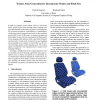Free Online Productivity Tools
i2Speak
i2Symbol
i2OCR
iTex2Img
iWeb2Print
iWeb2Shot
i2Type
iPdf2Split
iPdf2Merge
i2Bopomofo
i2Arabic
i2Style
i2Image
i2PDF
iLatex2Rtf
Sci2ools
100
Voted
SMI
2007
IEEE
2007
IEEE
Texture Atlas Generation for Inconsistent Meshes and Point Sets
In order to compute texture atlases with low stretch and hardly visible texture seams existing texture mapping tools pose high demands on the quality of surface representations like consistent orientation, watertightness, or manifoldness which many models commonly used in day-to-day modeling practice fail to meet. In this paper we propose an approach that bridges the gap between requirements of high quality texture mapping tools and poor mesh connectivity of models used in practice. In the spirit of classical two-part mapping an intermediate proxy surface is created that can be processed by high quality texture mapping tools. The texture signal is transfered to the original geometry using a novel mapping technique. Avoiding a modification of the original geometry typical problems of mesh repairing approaches like approximation errors or feature corruption are circumvented. As our method poses almost no demands on connectivity it can also be applied to point clouds. Contrary to classi...
Related Content
| Added | 04 Jun 2010 |
| Updated | 04 Jun 2010 |
| Type | Conference |
| Year | 2007 |
| Where | SMI |
| Authors | Patrick Degener, Reinhard Klein |
Comments (0)

